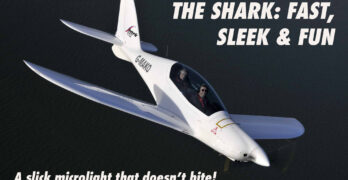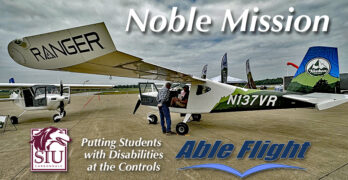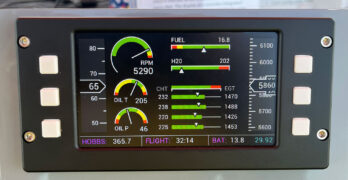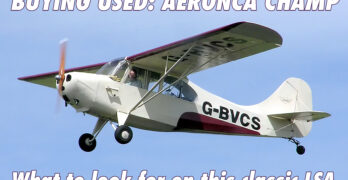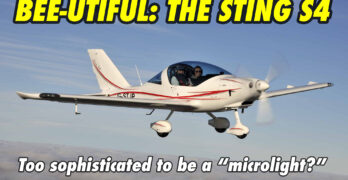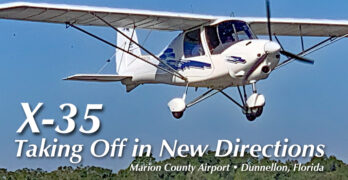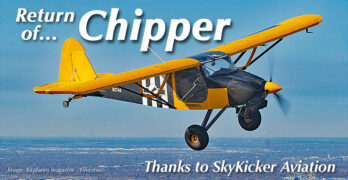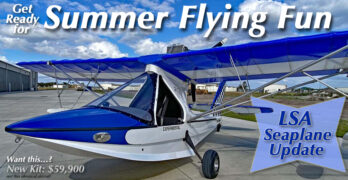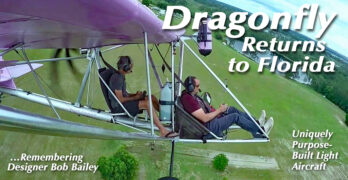“You never get a second chance to make a first impression” is a wise old saw, and my initial impressions of the Shark were all very positive. Some aircraft look like they’re moving even when they’re standing still, and the Shark definitely falls into this category. From the tip of the sharp-looking spinner to the top of the swept-back fin, it’s easily the sexiest-looking microlight I’ve ever seen. Indeed, my first thought is that it looks rather like a scaled-down PC-21.
Walking around the aircraft, I note that the 100-hp Rotax 912S is very tightly cowled, and that access to the engine bay is adequate, but not outstanding, as quite a lot of Camloc fasteners need to be undone to remove the entire cowling for a full engine inspection. There’s a large electrically actuated NACA scoop in the bottom half which supplies air to the oil cooler and radiator, and small intakes in the top half on both sides of the spinner for cooling the cylinders.
Search Results for : flight design ct
Not finding exactly what you expected? Try our advanced search option.
Select a manufacturer to go straight to all our content about that manufacturer.
Select an aircraft model to go straight to all our content about that model.
Able Flight’s Noble Mission — Hand Controls Help More Pilots Enjoy Light-Sport Aircraft
What if you had a powerful interest in flying but you needed special equipment? I don’t mean flat-screen avionics, powerful engines, or comfortable seats — though all those are indeed fun.
Instead, I refer to people who want to fly but may have challenges many of us don’t face. If you had a passion for flight but you had lost the use of your legs, must you just give up?
Not if Charles Stites and Able Flight have anything to do with it. Of course, personal determination is also required.
Enabling Flight
Charles founded Able Flight in 2006 with a believe that, “the life-changing experience of learning to fly is best shared.” He carefully designed the Able Flight Scholarships to enable people with disabilities to pursue that experience and he’s been nothing short of amazing in his success at this. Over 18 years of operation, Able Flight has awarded 130 scholarships minting 98 new pilots.
Wapsi Aero Debuts Multifunction Display at AirVenture
If you are piloting an ultralight or light plane VFR, you really don’t need an artificial horizon or a heading indicator. But you do need airspeed and altitude, and it’d be nice to have that available in a compact, clear, modern package. Even better, you’d like to make sure everything is happy in the power barn, as well as your airspeed and altitude.
In the spirit of providing everything you need and nothing you don’t, Wapsi Aero brought a bright and affordable electronic flight instrument that has generated quite a bit of buzz at AirVenture’s ultralight field. The rectangular instrument provides graphical engine data mid screen with airspeed and altitude in legible tape readouts on each side—combining a partial EFIS with an engine monitor. The screen is bright and easily readable, even in direct sunlight. The instrument also provides Hobbs and flight timers as well as battery voltage.
Even better, the Wapsi device is designed to fit into the same hole that may currently house a GRT EIS engine monitor—of which there have to be thousands in the field.
Buying Used: Aeronca Champ—A Plane That Deserves Your Respect
The Aeronca Champion might be the Rodney Dangerfield of light aircraft. The plane, which has historically played second fiddle to the Piper Cub, doesn’t get the respect it deserves, according to its fans. “Take all the light planes from that era and look at which offers the best characteristics… I would place the Champ at the top,” argues John Weigel, a Boston area pilot who twice flew a Champ from coast to coast. “I love the Cub,” he says, “but the Champ has no bad qualities. And if I’m taking someone up with me, I’ll take it over other similar planes every time.”
When compared to the Cub, as well as the Luscombe, Taylorcraft and Cessna 120 and 140, among other tailwheelers, the Champ is easier to get into, offers more comfort, has better visibility, more forgiving landing gear and is probably the better training/low-time pilot aircraft. All are good reasons to consider a Champ if you’re looking for a simple, relatively inexpensive and fun to fly aircraft.
Flight Review: The Sleek Sting S4
“Look at that groundspeed!” I exclaimed, pointing at the Garmin EFIS. “Our TAS is nearly 125 knots, which means we’ve got a 60 knot headwind straight on the spinner!” “Can you imagine being up here in a traditional microlight?” asked the Sting’s owner, John Palmer. “No, because not only would I be scared out of my mind at the prospect of having to land, but right now we’d practically be going backwards!” I said.
I’ve written before about just how capable and potent the new breed of light sport microlights is, and several of the aircraft I’ve tested recently are not only comparable to traditional GA types, but are demonstrably superior. An excellent representative of this new breed of speedy sport planes is the Sting S4, from Czech airframer TL Ultralights.
As I wait at Saltby for John to arrive in the Sting, I’m aware that it’s extremely windy, and that if I’d told someone that I was planning on flying a microlight in such conditions, they’d probably think I was mad—or suicidal.
MOSAIC – A Different Perspective
A lot has been written about the contents of the MOSAIC NPRM and many people and organizations have been able to comment on it to the FAA. Much of the commentary has been around the extension, or in some cases, curtailing of existing privileges for Sport Pilots, aircraft that can fit into the Light Sport definition and Light Sport Repairman certifications. I don’t plan to re-hash any of that here. This article will focus on what some of these changes could mean, in practical terms, to the market for Light Sport Aircraft and its customers. As you will see, it has the potential to be highly disruptive which not everyone will be happy about but will do so in a way that also opens up opportunities to a wider audience.
Before delving any deeper, let’s dispel the myth held by some in general aviation that Light Sport has been a “failure”.
Grassroots Success Story — Dunnellon’s X35 Attracts New, Younger Aviation Businesses
If I’ve heard one lament repeatedly over a long career, it is that current pilots don’t see enough new pilots coming into aviation. Are you one who worries a little or a lot about that? If not, you are a rare pilot.
Is it any wonder, though? The price of aircraft is way, way up. This applies to used aircraft and new — just like it does with your groceries or gasoline. The cost of maintenance is high and rising. Insurance is very expensive (for airplanes as well as cars or houses). Hangars are unavailable with years-long waiting lists at many airports.
More than ever it can seem, aviation is an activity for those with fairly thick wallets. The squeeze on modest budgets has rarely been this demanding.
Yeah, all that, but this website nonetheless discovers the affordable end of aviation. In that pursuit, I was drawn to an airport with an encouraging twist on the affordability squeeze play.
Like Phoenix Rising, Belite Chipper Returns to Production by SkyKicker Aviation
Welcome back to the airplane equivalent of an old friend. As you can see at the bottom of this post, Videoman Dave and I did many video interviews with Chipper creator. James Weibe (view at bottom). Pilots seemed always to enjoy hearing about his latest development.
James came to aviation from the computer business, where the pace isn’t fast — it’s furious! Over the years Dave and I covered James and his output, we’d make a new video at every airshow, it seemed, as he had moved on from the last design to the next. That’s what they do in the world of computers but it made pilots’ heads spin.
It also probably slowed sales because, as with computers, why buy this airplane when the next one will be even better?
It Began with Kitfox Lite
James started out with the Kitfox Lite single place Part 103 ultralight vehicle. Current Kitfox owners did not plan to pursue the single seater that Kitfox founder Dan Denney had created years earlier.
Summer’s Almost Here! State-of-the-Sector Report for LSA Seaplanes
One of the most active sectors in light aviation is LSA seaplanes. We’ve seen ups and downs, arrivals and departures of LSA seaplane producers. Admittedly, these flying machines are more complex than current-day LSA. For example, amphibs need retractable landing gear and substantial boat hulls able to take water loads.
LSA seaplanes constitute a highly fluid market yet we can see clues suggesting what might be ahead for some of the main brands. With summertime approaching, this State-of-the-Sector article attempts to keep up with the rapidly changing landscape (or waterscape).
We’ll first look at two high-end entries that have been in the news and conclude with present LSA seaplanes and their status in the market.
Vickers Wave
Writing for AVweb (part of Firecrown, which also owns Flying and ByDanJohnson.com plus several other publications), my fellow aviation journalist Russ Niles stated, “New Zealand-based Vickers Aircraft Company says it intends to make its first delivery of the Wave two-place amphibious aircraft to a U.S.
Dragonfly Is Back Home in Florida — Hang Glider Tug … Working Ranch “Tractor”
Dragonfly was born in Florida in the early 1990s. Back-of-the-napkin sketches started in the 1980s following the dynamic 1970s when hang gliding swooped into national awareness. What one designer did with Dragonfly would become one of the most celebrated developments in hang gliding.
Throughout the ’70s, hang glider designs accelerated smartly in glide performance and sink rate, stretching from slope-hugging 4:1 triangular-shaped wings to elegantly long and slender “bladewings” that could exceed a 20:1 glide yet remain foot-launchable and still be an aircraft you could carry on your shoulder (when folded down). Passionate enthusiasts thrilled to a 5X performance improvement in a decade or so.
In the beginning, most pilots launched off mountains to get enough height to catch thermals. Yet lots of America doesn’t have mountainous terrain. Florida had plenty of pilots eager to fly hang gliders but to find the best soaring, they had to load up their gliders and drive 10-12 hours to the hills of Tennessee where flight park operators like me catered to them with mountain launch sites.
- « Previous Page
- 1
- 2
- 3
- 4
- 5
- …
- 146
- Next Page »


